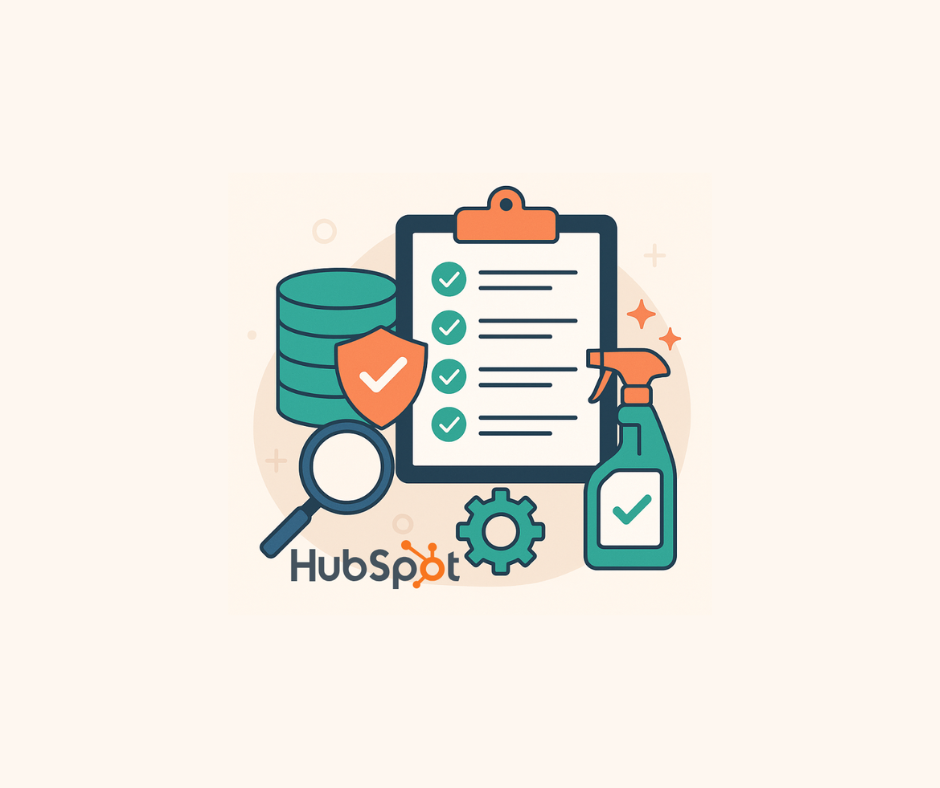
The Essential HubSpot CRM Data Hygiene Checklist for Clean & Powerful Data
The Unsung Hero of CRM Success – Clean Data
Ever pulled a report from your CRM that just didn’t add up? Or worse, sent a personalized email starting with “Hello [FirstName]” because a contact’s name field was empty? These are the tell-tale signs of dirty data – the silent saboteur of even the best CRM strategies.
What is CRM Data Hygiene? In the context of HubSpot, CRM data hygiene refers to the practice of maintaining the accuracy, completeness, consistency, timeliness, and relevance of the information stored in your contact, company, deal, and ticket records. It’s about ensuring your data is reliable enough to drive critical business decisions.
Why It Matters (The Stakes): The impact of neglected data hygiene is far-reaching and costly:
Wasted marketing spend on inaccurate segments or bounced emails.
Poor sales follow-up due to outdated contact information or incomplete lead context.
Inaccurate reporting and forecasting, leading to misguided strategies.
Damaged sender reputation from high bounce rates and spam complaints.
A poor customer experience when interactions are inconsistent or unpersonalized.
Conversely, the benefits of clean data are transformative:
Improved personalization for more effective marketing and sales outreach.
Precise segmentation for highly targeted campaigns.
Reliable forecasting and reporting that builds trust in your metrics.
Increased sales productivity as reps spend less time cleaning data and more time selling.
A significantly higher ROI from your entire HubSpot investment.
This post will provide you with your essential, comprehensive checklist to tackle data hygiene head-on in your HubSpot portal. Get ready to transform your data from a liability into your most powerful asset.

Before You Begin: Setting the Stage for Success
Before you dive into the nitty-gritty of cleaning, a little preparation goes a long way. This foundational work ensures your data hygiene efforts are effective and sustainable.
A. Define Your Data Standards: What does “good data” look like for your organization? This is your North Star.
Which fields are absolutely required for every contact or company?
What are the formatting rules for phone numbers, addresses, job titles, or dates? (e.g., “all states must be spelled out,” “all phone numbers must include country code”).
How should “Lifecycle Stage” or “Lead Status” be managed and updated? Document these standards clearly.
B. Identify Key Stakeholders & Responsibilities: Data quality is a team sport, not just an admin’s job.
Who “owns” data quality in Sales? In Marketing? In Customer Service? In Operations?
Define clear responsibilities for data entry, review, and correction at each stage of the customer journey.
C. Understand HubSpot’s Built-in Tools: HubSpot provides powerful features to aid in data hygiene. We’ll explore how to leverage them throughout this checklist, including:
The “Manage Duplicates” tool.
Workflow automation.
Property settings (e.g., required fields, validation rules).
HubSpot Operations Hub capabilities (for advanced automation and data quality, if applicable).
The Essential HubSpot CRM Data Hygiene Checklist
Let’s get practical. Here’s your actionable checklist to ensure your HubSpot CRM remains a reliable source of truth.
A. Contact & Company Record Integrity:
Duplicate Records (Contacts & Companies):
Key Action: Regularly use HubSpot’s built-in “Manage Duplicates” tool. Navigate to
Contacts > ContactsorContacts > Companies, then click “Actions” > “Manage Duplicates.” Review and merge suggested duplicates.Key Action: Establish a process for manual review and merging of duplicates that HubSpot’s tool might miss (e.g., similar names but different email domains). Train your team on this process.
Missing Critical Information:
Key Action: Identify and systematically populate missing core fields (e.g., Email, Phone Number, Company Name, Lifecycle Stage, Lead Status). Use HubSpot reports to find records with blank essential properties.
Tip: Make essential fields “required” for manual record creation or import. Go to
Settings > Objects > Contacts (or Companies) > Properties, select a property, and check the “Make this field required” box for forms, record creation, or deals.
Standardized Formatting & Consistency:
Key Action: Review existing data and enforce consistent formatting. For example, ensure all “Job Titles” use consistent casing, “States/Countries” use full names or standard abbreviations, and “Phone Numbers” follow a single format. Use HubSpot’s “Data Quality Automation” in Operations Hub (Pro/Enterprise) for automated formatting.
Key Action: Whenever possible, use dropdown select, radio select, or checkbox properties instead of free-text fields. This forces users to choose from predefined options, ensuring consistency (e.g., for “Industry,” “Lead Source,” “Company Size”).
Outdated Contact Information:
Key Action: Implement processes to identify and manage bounced emails, unsubscribed contacts, or contacts showing no engagement. Use list segmentation to create “unengaged” lists. Consider re-engagement campaigns or a “sunset policy” to remove truly unengaged contacts.
Key Action: Regularly review properties like “Last Activity Date,” “Last Contacted,” or create custom date properties (e.g., “Last Verified Date”) to track data freshness.
Correct Associations:
Key Action: Ensure contacts are correctly associated with their respective companies, and that both are linked to relevant deals or tickets.
Key Action: Periodically audit for “orphaned records” – contacts without an associated company, or deals/tickets without associated contacts or companies – and resolve these linkages.
B. Deal Pipeline Health:
Stale or Stuck Deals:
Key Action: Define what constitutes a “stale” deal for your business (e.g., no activity in 15 days, no stage change in 30 days). Create custom filtered views or reports in HubSpot to easily identify these deals.
Key Action: Implement HubSpot workflows to automatically remind deal owners about stale deals, or even move deals to a “Stalled” or “Re-engagement Needed” stage if criteria are met.
Inaccurate Deal Stages & Amounts:
Key Action: Sales managers should regularly review deals to ensure they are in the correct stage based on your defined entry/exit criteria. Coach reps on accurate pipeline management.
Key Action: Verify that deal amounts and close dates are accurate and up-to-date, especially for reliable sales forecasting.
Deals Missing Key Information:
Key Action: Ensure all deals have associated contacts/companies.
Key Action: Use the “Set properties for a deal stage” feature (
Settings > Objects > Deals > Pipelines Tab) to make sure required custom deal properties are filled before a deal can advance to the next stage (e.g., requiring “Next Steps” or “Decision Maker Identified” before moving to “Proposal Sent”).
C. Property Management & Optimization:
Unused or Redundant Properties:
Key Action: Conduct a property audit at least once a quarter. Identify custom properties that are no longer being used, are duplicates of existing HubSpot properties, or are no longer relevant.
Tip: Before deleting a property, use the “Used in…” feature (
Settings > Objects > Properties > [select property] > Used in) to see where it’s referenced (forms, workflows, reports). Archive or delete properties only after confirming they won’t break anything.
Inconsistent Property Values/Types:
Key Action: Review property types to ensure they are appropriate for the data being captured (e.g., a “number” field for a quantity, a “date picker” for a date).
Key Action: Consolidate similar property values. For example, if you have “USA,” “U.S.A.,” and “United States” in a text field, standardize them to one value using a workflow or a simple import/export and re-import.
Clear Property Descriptions:
Key Action: Ensure all properties, especially custom ones, have clear internal descriptions (the “Internal name” and “Description” fields when editing a property). This helps users understand the property’s purpose and how it should be used.
D. List & Workflow Accuracy:
Active List Criteria Review:
Key Action: Regularly review the logic of your active lists to ensure their criteria are still accurate and they are pulling the correct records. Outdated list criteria can lead to incorrect segmentation and targeting.
Workflow Enrollment & Action Audit:
Key Action: Periodically check that your workflows are enrolling the intended contacts/companies/deals and performing the correct actions without error.
Key Action: Review for unintended consequences, infinite loops, or conflicts with other workflows. HubSpot’s workflow history is invaluable here.
Archive Old/Unused Assets:
Key Action: Don’t delete, but archive lists, workflows, and forms that are no longer active or in use. This reduces clutter, improves load times, and prevents accidental use of outdated assets.
E. User & Team Management (Security & Organization):
Deactivate Former User Accounts:
Key Action: Promptly deactivate HubSpot user accounts for individuals who have left the company. This is crucial for security and data integrity. HubSpot will guide you to reassign ownership of their records.
Review User Permissions & Roles:
Key Action: Periodically audit user permissions and roles to ensure that users have the appropriate level of access for their current role (the Principle of Least Privilege). Overly broad permissions can lead to accidental data changes or security risks.
Correct Team Assignments:
Key Action: Verify that contacts, companies, and deals are assigned to the correct teams. This impacts reporting, access, and routing rules.
Making Data Hygiene a Habit: Ongoing Maintenance Strategies
Data hygiene is not a one-time project; it’s an ongoing commitment. Implement these strategies to embed data cleanliness into your daily operations:
A. Schedule Regular Audits: Establish a cadence for data audits. This could be weekly spot checks for common issues, monthly deep dives into specific data sets, or quarterly comprehensive reviews of properties and pipelines.
B. Leverage HubSpot Automation:
Utilize HubSpot Workflows to automate mundane data hygiene tasks:
Automatically format properties (e.g., capitalize first letters in names).
Create tasks for sales reps to review and update incomplete records.
Update properties based on specific triggers (e.g., change “Lead Status” if no activity for X days).
If you have HubSpot Operations Hub (Professional/Enterprise), leverage its advanced capabilities for:
Automated data sync: Ensure consistent data across all connected apps.
Data quality automation: Set up automatic deduplication, formatting, and property validation rules at scale.
C. Train Your Team Continuously:
Emphasize the “why” behind data hygiene. Help your team understand how clean data directly benefits them (better targeting, more accurate commissions, easier reporting).
Establish clear SOPs (Standard Operating Procedures) for data entry and updates.
Instill the “Garbage in, garbage out” philosophy: the quality of insights you get depends on the quality of data you put in.
D. Document Your Data Standards & Processes: Create a central, accessible knowledge base (e.g., in HubSpot’s Knowledge Base, Notion, or Google Docs) that outlines your data standards, property definitions, and data hygiene procedures.
E. Appoint a Data Steward/Champion (Optional but Recommended): Designate someone within your team (e.g., a Sales Ops specialist, Marketing Ops manager, or RevOps leader) who is responsible for overseeing and championing data quality efforts.
F. Monitor Key Data Quality Metrics: Track metrics that indicate the health of your data, such as:
Duplicate rate.
Percentage of incomplete records (for critical fields).
Email bounce rates.
Percentage of stale deals.
Unlock the True Power of Your HubSpot CRM
Clean data is not just an administrative chore; it is the unsung hero of CRM success. It transforms your HubSpot portal from a mere database into an intelligent, reliable engine for marketing personalization, sales productivity, accurate forecasting, and exceptional customer experiences.
By diligently following this data hygiene checklist, you will gain the clarity and confidence needed to make smarter decisions, execute more effective strategies, and ultimately, drive significantly higher ROI from your entire HubSpot investment.
Data hygiene is an ongoing process, not a one-time fix. Start small, tackle one area at a time, and be consistent. The tangible business improvements will speak for themselves.
Ready to transform your HubSpot CRM into a truly powerful growth engine?
Data hygiene can be a complex undertaking, but you don’t have to tackle it alone. Mobius NEXT specializes in HubSpot optimization, data strategy, and operational excellence. Our experts can help you implement these hygiene practices, automate processes with Operations Hub, and ensure your data consistently serves your business goals.
Which item on this checklist will you tackle first? Share your own HubSpot data hygiene tips in the comments below!
for a personalized data hygiene audit and strategy, contact Mobius NEXT today.
Resources:
HubSpot Knowledge Base (Data Management, Duplicates, Properties):
HubSpot Blog (Sales, Marketing, Operations):
HubSpot Academy:



